How Important are Hair Transplant Technicians?
When evaluating hair transplant clinics, patients seem to universally focus on one thing: the doctor performing the hair transplant. This is logical; your hair transplant physician will perform a permanent, life-altering procedure on one of the most visible regions of the body. Things like experience, track record, and transparency matter. With the advent of the internet, it’s easier than ever to review and evaluate doctors based on this criteria. Check any forum, sub-thread, or comment section of a YouTube video, and you will find dozens of patients discussing different doctors. And, of course, it is crucial to thoroughly vet doctors and go into a procedure confidently with full informed consent. But what if I were to tell you that there was one crucial criteria that is often overlooked? One that could determine the entire outcome of your procedure; but one that patients may be fully unaware of and not ask a single question about before surgery? It may sound unbelievable, especially when considering how thoroughly patients research before scheduling a procedure, but it’s very real. So, what is this mystery criteria? Hair Transplant Technicians
Who are the Hair Transplant Technicians?
Hair transplant technicians are highly trained medical assistants, often times registered medical assistants (MA) or surgical technicians, who assist during hair transplant procedures. Unlike
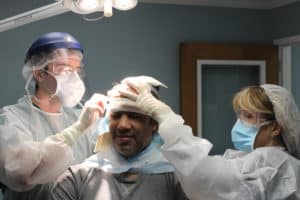
A super technician assisting Dr. Bloxham during strip extraction.
some medical or surgical procedures where an assistant may be in charge of setting up tools or handing things to a doctor, however, hair transplant technicians actively participate in surgery. That’s right, a hair transplant technician plays a highly important role in your surgery; a role that has a direct impact on your results. So, what type of role do they play? What are the responsibilities of a hair transplant technician?
Role of Hair Transplant Technicians
The role of a hair transplant technician varies depending upon the type of procedure being performed: FUT (Follicular Unit Transplantation or “strip”) or FUE (Follicular Unit Excision) — we will discuss technicians and FUE a different time.
During an FUT procedure, technicians are responsible for two key aspects of surgery: the first is microscopic dissection of the follicular unit grafts. During an FUT procedure, a narrow strip of hair-bearing skin is removed from the donor region. Since the strip is taken out as one unit comprised of thousands of individual follicular units, the strip must be continually divided — or dissected — into smaller and smaller pieces until we have only true, natural follicular units left. These become the follicular unit “grafts” that we then implant into the bald and thinning regions. A follicular unit is less than 1mm in size, and an average size FUT “mega-session” procedure calls for 2,500 – 3,000 grafts. To create 2,500 – 3,000 perfect pieces of tissue less than 1mm in size, a technician needs incredible skill, lots of practice and experience, and a high level of comfort using powerful microscopes. This aspect of the procedure is on the level of micro-surgery, and is performed meticulously under microscopes by the technicians. Additionally, it is not just one technician performing this; it takes a small army to dissect a strip containing 2,500 – 3,000 grafts. For reference, a “super technician” can handle around 400 – 600 grafts during a case. So, for a 2,500 graft case, for example, we would need 6 technicians. This means 6 individuals performing precise surgical dissection under microscopes at the same time. If the technician does not know how to dissect the tissue or is overwhelmed because they are trying to dissect too much or do not have the experience/skill required, your precious grafts will be destroyed. It does not matter how well the doctor removed them, it is the technician who determines whether or not they are properly prepared and if they even survive and make it to the implantation phase.
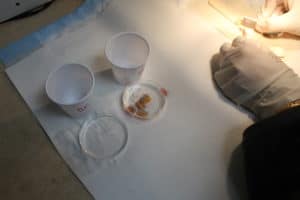
A technician preparing grafts under the microscope.
This brings us to the next important role of a technician during an FUT procedure: graft placing or graft insertion/implantation. While the technicians are dissecting the grafts under microscopes, the doctor will begin making incisions or “recipient sites” in the bald/thinning regions where the new grafts will be placed. After the incisions are done and the grafts are all prepared, each follicular unit needs to be carefully placed into each recipient incision. This means for a 3,000 “graft” case, 3,000 incisions are made and 3,000 grafts — which are fragile and less than 1mm in size — must be gently placed into each incision. Who do you think places the grafts? You guessed it: the technicians. Using a variety of different placing methods, the most common being placement with forceps (medical tweezers) and a needle, the technicians place each graft by hand. As previously discussed, these grafts are extremely small and very fragile. Grasp the graft too hard and the delicate follicle will be crushed. Slide the graft into the incision wrong and the follicle will bend or smash and, again, be crushed and die. The technician must use high magnification and extreme focus to gently glide each graft into each tiny incision without damage. Furthermore, they must do so in an efficient and timely manner to ensure the grafts do not spend too much time out of the body — which decreases survival rate. Much like the dissection process, graft placement is crucial. If the technicians do not place the grafts correctly or if they become fatigued and begin to handle the grafts too “roughly,” the grafts will die and the procedure will fail. During your procedure, you must have multiple technicians with lots of graft placing experience and a rigid protocol handling the grafts. Anything less is unacceptable.
How are the Technicians Trained?
So, how are these technicians trained for such a crucial role in surgery? There must be a hair transplant technician “school,” right? Believe it or not, technicians are trained by the clinics
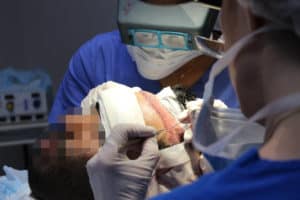
Two technicians place grafts during an FUT procedure.
themselves. The doctors must know not only how they want the technicians to practice, but must also know how to teach them to do so. Quality clinics view themselves not only as hair transplant providers, but also as hair transplant technician trainers. Good clinics create rigid, evidence-based protocols for cutting and placing, and spend large amounts of resources building the right environment for technicians to thrive. They need the proper microscopes, ergonomic cutting stations, comfortable magnifiers (“surgical loops”), and placing tools. Most importantly, however, they need to be taught exactly how to cut and place and have doctors willing to work with them and continually monitor for quality. If clinics are not willing to dedicate the time and resources to doing this or if they think they can just “borrow” technicians from other clinics or agencies advertising independent, “traveling” technicians — who go from clinic to clinic participating in surgery only when needed — they will not have high quality staff. Period.
How do you Ensure The Clinic Has Quality Technicians?
So now you understand the importance of quality, “super technicians.” That’s great. But how do you figure out which clinics have the right technician staff? How can you, as a patient, tell which offices utilize large, trained, in-house staffs, and which contract with traveling technicians or only have a few full-time technicians? Since it’s unlikely that you can meet the technicians themselves, you must, instead, ask thorough questions about the tech staff during your consultation. Here are the questions you must ask the doctor during your consultation and the right, and wrong, answers:
Question 1: How many technicians do you use for surgery?
Answer 1: The correct answer is 1 technician for every 400 – 600 grafts. Anything besides this answer, including doctors themselves using things like “implanter pens” instead of technicians, is the wrong answer. You do not want only a few technicians who will inevitably become fatigued and frustrated. Your grafts and results will suffer.
Question 2: Are these technicians employed full-time by the clinic? Are these in-house staff or do you rely on traveling or independent contracting technicians?
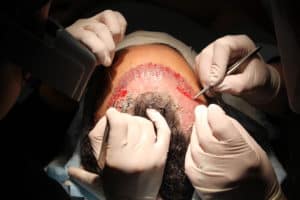
Close-up of technicians placing grafts during surgery.
Answer 2: The correct answer is that the technicians are employed exclusively the the clinic, they are full-time, they only work at the clinic, and they are the only ones who will touch you during your surgery. The clinic should tell you they never utilize “traveling” contracted technicians with unknown levels of experience, unknown protocols, and no responsibility to the patient or the clinic. Any answer involving traveling technicians, part-time technicians, or technicians who work elsewhere is a glaring red flag. You do not want your grafts prepared and handled by a team that has never worked together before with disparate methods and no incentive to do a good job.
Question 3: How much experience do your technicians have?
Answer 3: This correct answer has two parts: first, the technicians must have a lot of experience. Repetition using proper protocols is the only way technicians can gain skill. You want a technician to have years of hair transplant surgeries under their belt. You should also look for something else in an answer: ongoing training and new technicians being trained and groomed at all times. While these “newer” technicians will not play a big role in your procedure or impact your results, you want a clinic with both a skilled current and future technician staff. This is a dedicated clinic “in it” for the long-term.
Question 4: Who trained the technicians?
Answer 4: The technicians should be trained by the doctor at the clinic. You do not want technicians who were trained elsewhere or who work under a doctor who does not know how to train technicians. These technicians tend to have “bad habits” and these doctors don’t know how to identify and fix problems.
Are These the Right Technicians for your Case?
So, now you understand the importance of quality hair transplant technicians and the crucial role these “super technicians” play in surgery. The right staff can have an enormous impact on your 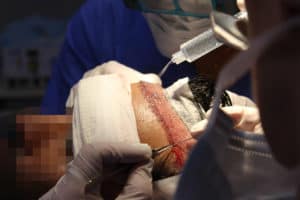
________
Dr. Blake Bloxham
Feller & Bloxham Medical, PC





